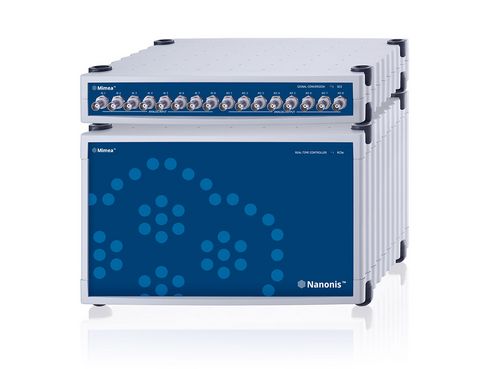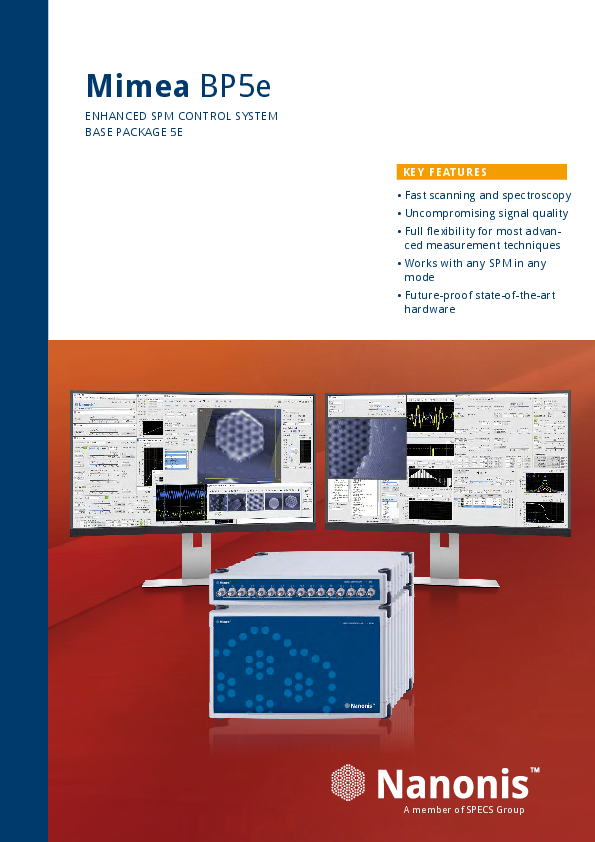Mimea upgrade from BP3 to BP5e
Upgrading from a BP3 to a BP5e brings a massive performance increase and a vastly improved user interface. All relevant parameters have been improved by at least one order of magnitude. Moreover, the update ensures repairability and availability of spare parts.
Nanonis V3 SPM control systems were discontinued mid 2007 and reached their end of life in 2015. While many of these systems are still in operation, development at Nanonis hasn't stood still and the current generation of controllers is miles ahead both in performance and usability. Spare parts for V3 SPM control systems are no longer available, meaning that the V3 hardware cannot be replaced or repaired anymore.
The upgrade offers a straightforward path to current state of the art electronics and software, without requiring users to learn how to operate a completely different system.
Some of the benefits related to the upgrade:
- Flexible signal assignment with 128 live signals
- Flexible signal handling, software modules have access to more signals
- 64-bit software, more memory available for data buffering, more channels can be acquired simultaneously
- Fast scanning and spectroscopy (up to 1.000.000 pixels per second) on up to 8 channels
- Direct data streaming to disk with up to 1 Mpix/s on up to 8 channels simultaneously
- Multi-pass improvements including possibility to write scripts running on the real-time system resulting in significant increase in speed and flexibility for advanced multi-pass experiments like KPFM
- Letterbox scanning allows selecting two boundaries on the Y axis of the scan placed within the scan frame allowing the tip to be bounced within these two boundaries
- Region of interest allows selecting a frame within the scan frame resulting in better tilt compensation for this sub-frame (e.g. on atomic terraces) or optimization of the colorscale only within the sub-frame
- Improved safety for user inputs solves the difficulties encountered if you forget to use units when changing a parameter in the software
- Improved “accessibility” of displayed data in graphs; functions of zooming, moving cursors and panning through a graph now accessible directly on the plot depending on the position of the mouse. Zooming can be done using the scroll wheel
- Multiple past function including management of several background images in the scan control module
- New oscilloscope with two channels instead of one, enhanced triggering and display options, with high resultion high speed oscilloscope/FFT add-on option with up to 1 million points per trace (user selectable), 1 MS/s sampling rate, 100 kHz analog bandwidth
- New programming interface add-on with LabVIEW and a generic script-language TCP-interface
- New and completely different lock-in add-on with advanced signal filtering, tandem-demodulation, multi-frequency and multi-input options, up to 8 independent synchronizable modules, guided filter set-up utility
- New multi excitation add-on module for Q-control, dual- and multi-frequency excitation schemes, amplitude modulation, Sideband detection
- Possibility to extend hardware to up to 40 analog outputs and 24 analog inputs
- Simple extension to the multiprobe control system
- Simple extension to Nanonis Tramea for quantum transport measurements
Compatible instruments:
- RTPC (19" rack-mount)
- First generation PXI-based real-time controller
Not compatible for this upgrade:
- RC4
The upgrade includes:
- Replacement (trade-in) of PXI controller and SCCB, RTPC and SCCB with a discounted BP5e
The OCB oscillation controller also needs to be replaced (AFM systems only). High-voltage amplifiers and adaptation kits can be reused.
EOL information for V3 systems:
The following discontinued V3 instrument models have reached their end-of-life and no repair service or support will be provided anymore:
- RTPC (19" rack-mount)
- First generation PXI-based real-time controller
In case of hardware failure the instruments need to be replaced by an instrument of the currently available product line.
The following discontinued V3 instrument models have reached their end-of-life and repairs cannot be guaranteed anymore:
- All 19" rack-mounted instruments except RTPC
In case of hardware failure the instruments might need to be replaced by an instrument of the currently available product line.
SPECIFICATIONS
| Analog inputs | If not otherwise specified, all specifications for ±10 V input range |
| Number of Connectors | 8x BNC connector, differential |
| Differential input voltage range | ± 10 V |
| Differential input voltage range | ±10 V, ±1 V, ±100 mV, ±10 mV (with MCVA5) |
| Differential input impedance | 2 MΩ |
| Input impedance | >10 TΩ to GND, >50 GΩ differential (with MCVA5) |
| Input bias current | <2 pA typ. (with MCVA5) |
| Analog bandwidth | DC – 100 kHz (-3 dB), 5th-order Butterworth low-pass filter |
| AD-converter | 18-bit, no missing codes, 1 MS/s |
| Effective resolution | 20-bit @ 60 kS/s, 22-bit @ 1 kS/s (oversampling) |
| INL | ±2 LSB typical |
| DNL | ±1 LSB typical |
| Input noise density | < 150 nV/√Hz @ 10 kHz, < 650 nV/√Hz @ 10 Hz |
| Input noise density | <4 nV/√Hz (<5.5 nV/√Hz) @10 kHz SE (differential) |
| Input measurement noise | < 100 μVrms @ 1 MS/s, < 25 μVrms @ 60 kS/s, < 6.5 μVrms @ 240 S/s |
| Input noise 0.1 Hz - 10 Hz | <25 nVrms (< 32 nVrms) SE (differential) |
| 12 h drift | < 80 μV (< 100 μV) @ 0 V (@ 9.9 V) |
| THD+N | > 120 dB @ 100 Hz, > 95 dB @ 1 kHz, |
| CMRR | >125 dB @ 10 Hz >120 dB @ 100 Hz >100 dB @ 1 kHz (with MCVA5 @ gain 100) |
| Analog outputs | all specifications for ±10 V output range |
| Number of Connectors | 8 x BNC connectors (SO5: 16x BNC connectors), referenced to AGND |
| Output voltage range | ±10 V into 1 kΩ or larger |
| Output impedance | <1 Ω, short circuit safe |
| Analog bandwidth | DC – 40 kHz (-3 dB), |
| DA-converter | 20-bit, 1-ppm precision, 1 MS/s |
| Effective resolution | 22-bit, patented hrDACTM technology with active glitch compensation |
| INL | < ±2 LSB max. < ±1 LSB typical |
| DNL | < ±1 LSB max. < 0.5 LSB typical |
| Output noise density | < 25 nV/√Hz @ 100 Hz, < 75 nV/√Hz @ 1 Hz |
| Output noise 0.1 Hz - 10 Hz | < 200 nVrms (0.1 – 10 Hz) |
| Output noise 10 Hz - 300 kHz | < 10 μVrms (10 Hz – 300 kHz) |
| 12 h drift | < 1.5 μV (< 25 μV) @ 0 V (@ 9.9 V) |
| THD+N | > 93 dB @ 100 Hz, > 93 dB @ 1 kHz, > 79 dB @ 10 kHz (9V output signal) |
| Digital lines |
|
| Number of Connectors | 4 x 8 bidirectional lines on four D-sub 9 female connectors |
| Signal | 3.3 V TTL, max. 25 mA per line |
| Maximum sampling frequency | 500 kHz |
| High-speed digital lines |
|
| Number of Connectors | 4 x inputs and 4 x outputs on SMB male connectors |
| Signal | 3.3 V TTL, max. 33 mA per line |
| Maximum sampling frequency | 200 MHz |
| Clock |
|
| Number of Connectors | 1 x input, 1 x output for active clock source on SMB male connectors |
| Frequency | 10 MHz, square wave, 3.3 V |
| Accuracy | ± 50 ppm (standard clock), ± 4 ppm (optional OCXO) |
| Operating temperature | +5° C to +35° C |
| Power Supply | RC5e: Built-in universal power supply, max. 220 W |
| Power Supply | SC5: Built-in linearly regulated power supply, toroidal transformer, automatic line voltage detection. Max. 51 W |
| Power Input | RC5e: 100 – 230 V, 50 - 60 Hz |
| Power Input | SC5: 100 – 240 V, 50 - 60 Hz |
| Real-time system | NI PxIe-8840 real-time system with Intel Corei5 CPU 2.7 GHz, 4 GB RAM |
| Operating system | NI LabVIEW Real-Time OS |
| FPGA card | NI PXIe-7976 |
| Connectivity | 3x SC5 max., 2x SO5 max., 2x OC4 max. Total of max. 6 frontends |
| Electrical GND | 10 kΩ AGND to chassis, decoupled from RC5e |
| Data transfer | Via TCP/IP, 2 kS/s default, up to 20 kS/s, 1 MS/s x 8 channels for data streaming |
| Dimensions | 32.5 x 28 x 21 cm (RC5e) |
| Dimensions | 32.5 x 28 x 7 cm (SC5) |
| Weight | 8 kg (RC5e) |
| Weight | 4.2 kg (SC5) |

